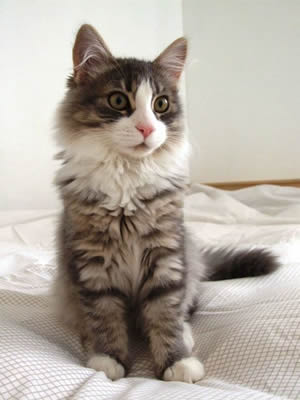Breed Standard
Head: Of medium size, round and slightly longer than broad. Moderately rounded forehead, pronounced cheekbones, and jowliness. Nose of medium length. Muzzle slightly longer than broad. Definite whisker break. Strong chin.
Eyes: Large and round. Color appropriate to coat color.
Neck: Short and thick.
Body: Compact and cobby. Broad chest. Short back. Rounded rump. Robust bone structure. Solidly muscled.
Paw: Hind legs are much longer than forelegs. Heavily boned. Muscular. Paws round and medium in size.
Tail: Short or absent.
Coat: Semilong, longer on underparts. Very silky texture. Double coat (abundant undercoat). Colors: Same varieties as the Manx (natural colors, tabby patterns, etc.).
History
A longhaired, tailless cat from Ireland A specific gene was responsible for the semilong coat of the cats living on the Isle of Man in the Irish Sea. In the 1960s, Canadian breeder Blair Wright and American breeder Leslie Falteisek decided to fix this characteristic and thus create a new longhaired Manx breed, the Cymric (Cymru means Wales in Gaelic). Around 1970, the Canadian Cat Association recognized the breed. Naming it Longhaired Manx, the C.F.A. recognized the breed in 1989. As of this writing, the F.I.Fe has not recognized the Cymric. This breed is almost unknown in Europe.
Behavior
This is a playful, active, hardy cat. The highly social Cymric readily acceptes strangers and gets along well with other animals. He is also gentle with children. Care is simple. Weekly brushing is sufficient.
Health
The gene that gives the Cymric and Manx their unusual tails can also be lethal. Kittens who inherit two copies of the tailless gene die before birth and are reabsorbed in the womb. Since these kittens make up about 25 percent of all kittens, litters are usually small. Even cats who inherit only one copy of the gene can have what is called Manx syndrome. This can cause spina bifida, gaps in the vertebrae, fused vertebrae, and bowel or bladder dysfunctions. Also, a rabbit-like hop can sometimes be seen in Cymric cats due to the spinal deformity.
Not every Cymric with a short spine has problems or Manx syndrome. It is simply an attribute of the Manx gene, and its expression cannot be entirely prevented. As the problems usually become apparent within the first six months of age, Cymric and Manx kittens are usually kept by breeders until older before being made available.






